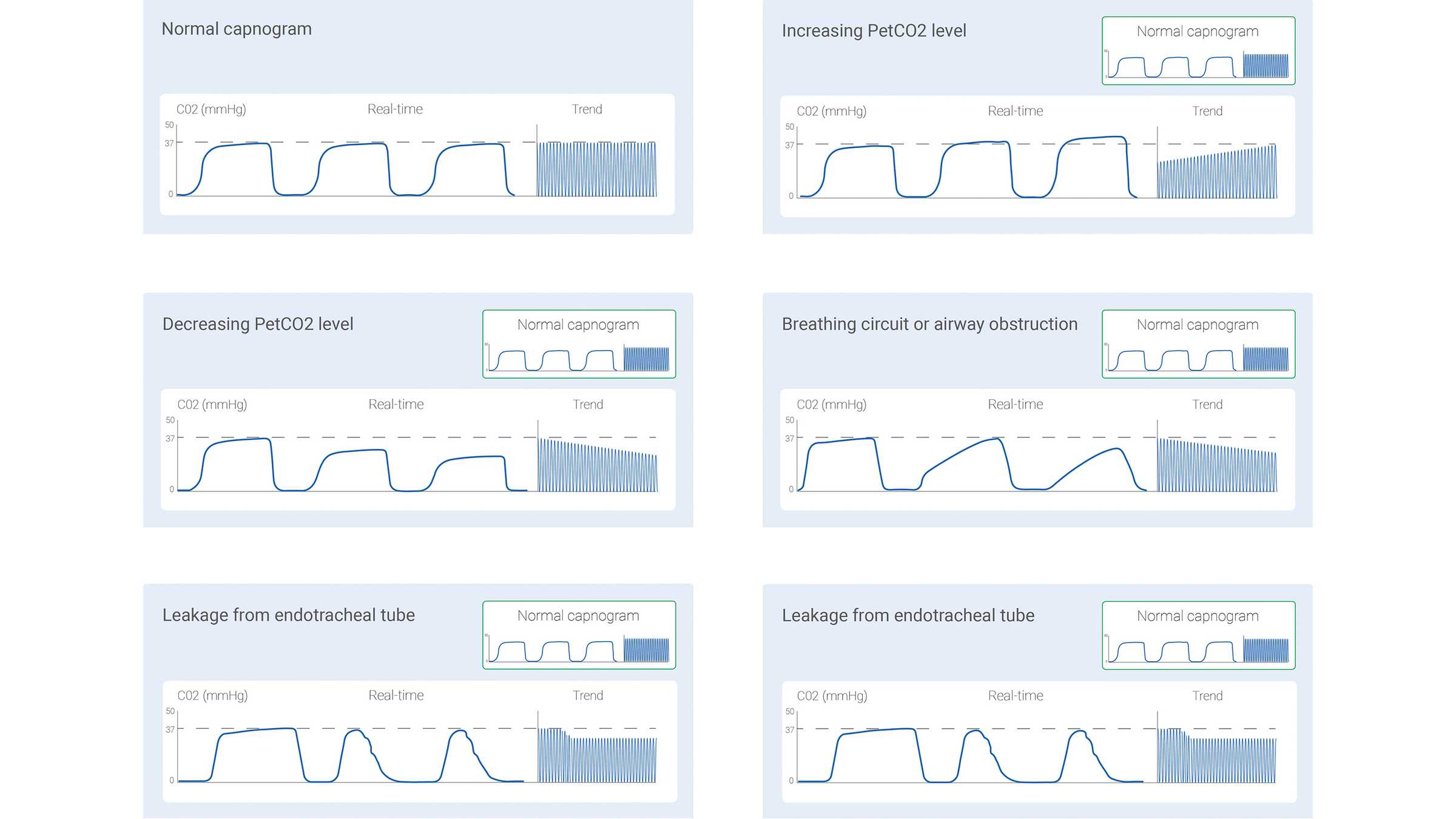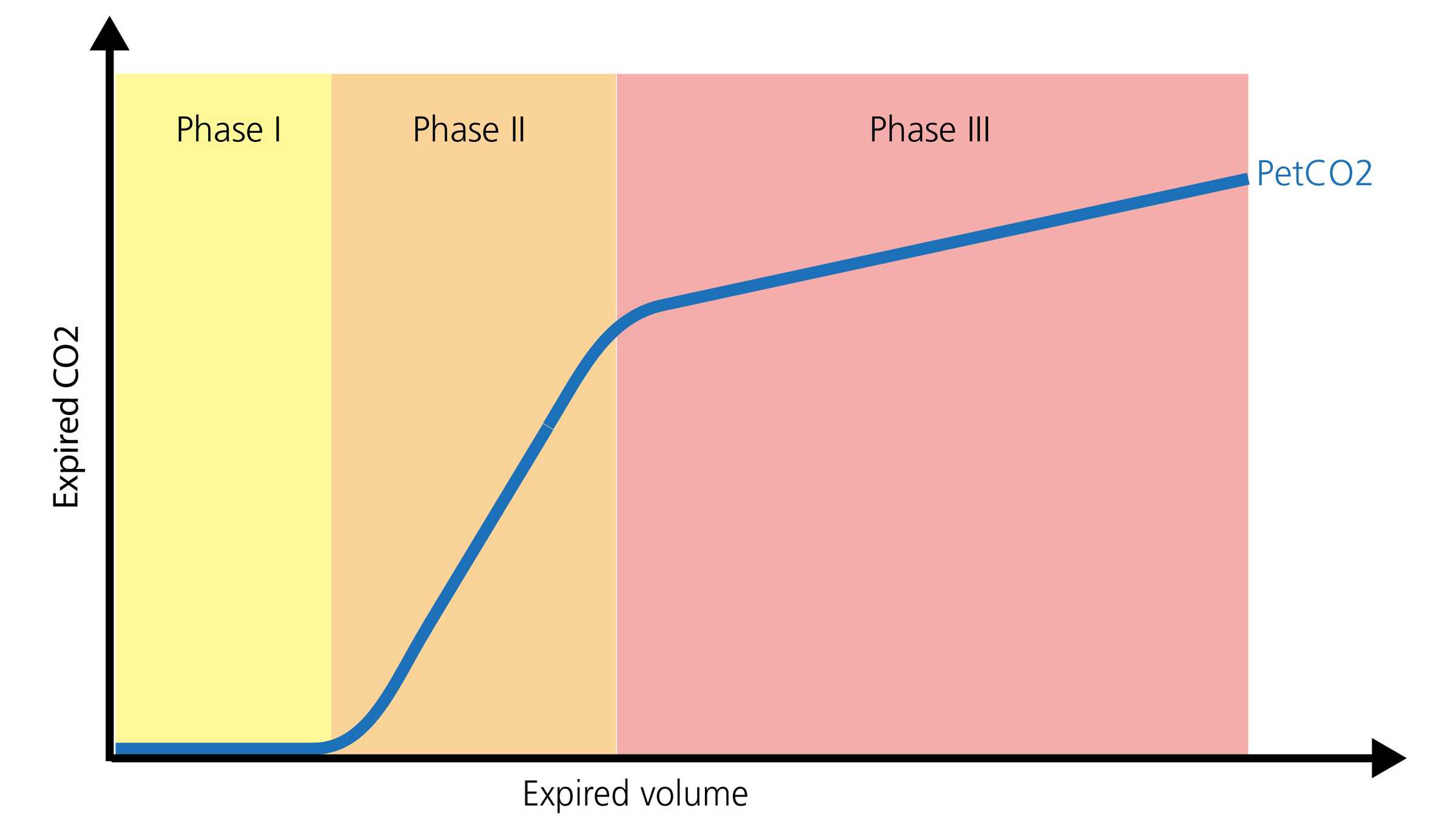
Autore: Joe Hylton, MA, BSRT, RRT‑ACCS/NPS, NRP, FAARC, FCCM, Specialista applicazioni cliniche, Hamilton Medical Inc.
Data: 15.07.2021
Le curve capnografiche sono ben note nel campo della medicina intensiva. Sono uno strumento molto utilizzato per confermare la validità dell'approccio alla gestione delle vie aeree e nell'ambito della sedazione cosciente, ma anche durante il trasporto tra una struttura e l'altra dei pazienti intubati e sottoposti a ventilazione meccanica. Le curve capnografiche possono fornire tempestivamente informazioni preziose al personale sanitario correttamente formato.

Fattori fisiologici che influiscono sull'end‑tidal CO2 (PetCO2)
Sono molti i fattori che possono influenzare la quantità di anidride carbonica presente nel gas espirato nella fase cosiddetta "end‑tidal" (PetCO2). Per garantire l'eliminazione della CO2 si ha un equilibrio preciso e continuo tra la produzione di CO2 nei tessuti, il suo trasporto nel sangue, la diffusione negli alveoli e l'eliminazione attraverso la ventilazione (
Un aumento o una riduzione del tasso metabolico del paziente determina una variazione nella produzione della CO2 e, di conseguenza, anche nella sua eliminazione. Se la circolazione e la ventilazione sono entrambe stabili (uno stato che si ottiene solo nei pazienti passivi ventilati meccanicamente) il monitoraggio della CO2 può essere utilizzato come indicatore della produzione della CO2. Febbre, sepsi, dolore e crisi convulsive sono tutte condizioni che aumentano il metabolismo, provocando un corrispondente aumento nella produzione della CO2 e quindi un aumento della PetCO2. Si verifica invece una riduzione del metabolismo nei pazienti ipotermici o sedati e paralizzati. Queste condizioni riducono la produzione di CO2 e possono portare a una diminuzione della PetCO2 se non si ha un contemporaneo aumento della ventilazione minuto (
Il trasporto di CO2 verso i polmoni dipende dal corretto funzionamento del sistema cardiovascolare, quindi qualsiasi fattore che altera la funzionalità cardiovascolare può influenzare anche il trasporto della CO2 verso i polmoni (
La rimozione della CO2 che fuoriesce dai polmoni e viene riversata nell'ambiente è influenzata dalle variazioni della funzionalità respiratoria. Le patologie polmonari ostruttive, la polmonite, i disturbi neuromuscolari e quelli del sistema nervoso centrale che compromettono la funzionalità respiratoria causano quindi una variazione del valore della PetCO2 (
Tipi di capnografia
Il segnale di CO2 misurato può essere registrato come funzione del tempo (capnografia basata sul tempo) o del volume espirato (capnografia volumetrica). La quantità di dati potenzialmente forniti da questi due diversi tipi di capnografia varia significativamente. In letteratura sono stati descritti alcuni pattern dei capnogrammi basati sul tempo che vengono ritenuti tipici di determinate situazioni cliniche. Alcuni dei più comuni sono mostrati di seguito, nella Figura 1.
Anche la capnografia basata sul tempo ha però dei limiti: non è in grado di fornire una stima accurata dello stato di ventilazione/perfusione dei polmoni e non può essere utilizzata per fare una stima della componente di spazio morto fisiologico. Nonostante non sia semplice e pratica come la capnografia basata sul tempo, la capnografia volumetrica ha il vantaggio di fornire molte più informazioni.
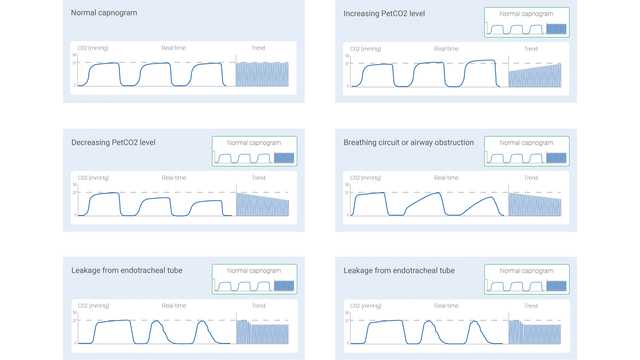
Il capnogramma volumetrico: forma e fasi
La forma normale di un capnogramma volumetrico è composta da tre fasi. È importante ricordare che il capnogramma rappresenta l'espirazione.
- La fase I rappresenta il gas senza la CO2 proveniente dalle vie aeree (spazio morto anatomico e dovuto agli strumenti).
- La fase II è una fase di transizione in cui il gas proveniente dai canali delle vie aeree si unisce al gas alveolare.
- La fase III è una fase di plateau, a cui contribuiscono il gas proveniente dagli alveoli e dalle aree dei polmoni che si svuotano lentamente (
Gravenstein, J., Jaffe, M., & Paulus, D. (2004). Capnography: Clinical Aspects. New York: Cambridge University Press.2 ). Di seguito, nella Figura 2, è riportata una rappresentazione delle tre fasi.
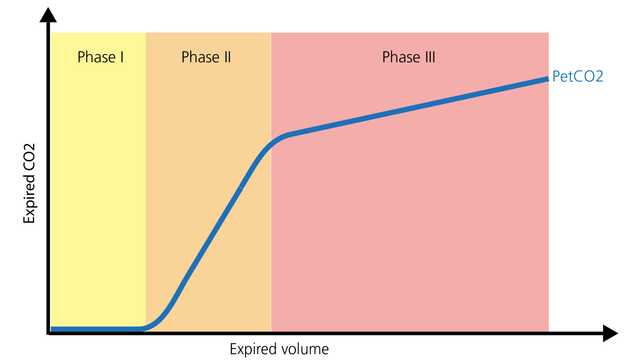
La capnografia durante il trasporto
La capnografia, sia essa basata sul tempo o volumetrica, è in grado di fornire informazioni preziose per ottimizzare il monitoraggio e guidare l'assistenza dei pazienti che devono essere trasportati all'interno dell'ospedale o da una struttura a un'altra. Può essere utilizzata in modo sicuro con tubi endotracheali, tubi tracheostomici e molte vie aeree sopraglottiche, purché la tenuta sia efficace. Il posizionamento e la pervietà delle vie aeree, il monitoraggio della ventilazione e lo stato di perfusione sono tutti ambiti in cui la PetCO2 fornisce informazioni significative. Un altro parametro prezioso è il volume dell'anidride carbonica eliminata al minuto (V'CO2), che consente al personale sanitario di valutare l'efficacia della perfusione e gli sforzi di reclutamento del volume (
La capnografia in terapia intensiva
Nel reparto di terapia intensiva, le curve capnografiche permettono il monitoraggio continuo del posizionamento e della pervietà delle vie aeree, fornendo anche una serie di dati aggiuntivi sulle vie aeree. Il rapporto tra spazio morto e volume corrente (VD/Vt) è un parametro capnografico importante. Un aumento del rapporto VD/Vt può riflettere un potenziale aumento della mortalità, a seconda dell'entità dell'aumento (
Tutti i ventilatori Hamilton Medical eseguono la capnografia volumetrica (
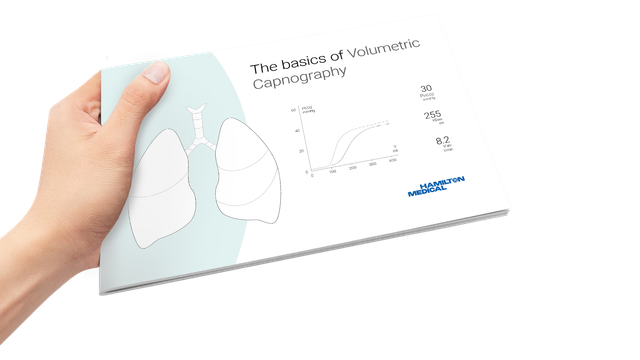
E‑book gratuito
Buono a sapersi! Tutto sulla capnografia volumetrica
Tutto quel che serve per interpretare un capnogramma volumetrico e avere una panoramica dei vantaggi e delle applicazioni cliniche della capnografia volumetrica. Comprende un test da eseguire in autonomia!
Note
- A. Tutti i modelli eccetto l'HAMILTON‑MR1
Bibliografia
- 1. Kremeier P, Böhm SH, Tusman G. Clinical use of volumetric capnography in mechanically ventilated patients. J Clin Monit Comput. 2020;34(1):7‑16. doi:10.1007/s10877‑019‑00325‑9
- 2. Gravenstein, J., Jaffe, M., & Paulus, D. (2004). Capnography: Clinical Aspects. New York: Cambridge University Press.
- 3. I‑Gnaidy E., Abo El‑Nasr, L., Ameen, S., & Abd El‑Ghafar, M. (2019). Correlation between Cardon Dioxide Production and Mean Arterial Blood Pressure in Fluid Response in Mechanically Ventilated Patients. Medical Journal of Cairo University, 87(4), 2679‑2684.
- 4. Kallet RH, Alonso JA, Pittet JF, Matthay MA. Prognostic value of the pulmonary dead‑space fraction during the first 6 days of acute respiratory distress syndrome. Respir Care. 2004;49(9):1008‑1014.
- 5. Nuckton TJ, Alonso JA, Kallet RH, et al. Pulmonary dead‑space fraction as a risk factor for death in the acute respiratory distress syndrome. N Engl J Med. 2002;346(17):1281‑1286. doi:10.1056/NEJMoa012835
- 6. Blankman P, Shono A, Hermans BJ, Wesselius T, Hasan D, Gommers D. Detection of optimal PEEP for equal distribution of tidal volume by volumetric capnography and electrical impedance tomography during decreasing levels of PEEP in post cardiac‑surgery patients. Br J Anaesth. 2016;116(6):862‑869. doi:10.1093/bja/aew116
- 7. Nguyen LS, Squara P. Non‑Invasive Monitoring of Cardiac Output in Critical Care Medicine. Front Med (Lausanne). 2017;4:200. Published 2017 Nov 20. doi:10.3389/fmed.2017.00200
- 8. Stapel SN, de Grooth HJ, Alimohamad H, et al. Ventilator‑derived carbon dioxide production to assess energy expenditure in critically ill patients: proof of concept. Crit Care. 2015;19:370. Published 2015 Oct 22. doi:10.1186/s13054‑015‑1087‑2
Related articles. Get a deeper look

The guide to the basics of volumetric capnography
Learn everything you need to know in our guide to volumetric capnography: the volumetric capnogram, the capnography phases, what is dead space, the difference between anatomical dead space and alveolar dead space, PetCO during bronchospasm, V‘CO and CO2 elimination, and more.
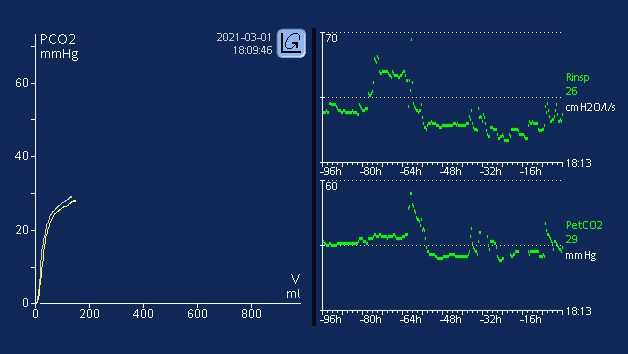
Using the Trend function for PetCO2
It is well established that metabolism, perfusion, and efficient lung function are paramount to effective CO2 transport and elimination (1). Changes in a patient’s metabolic state, perfusion, or lung function can affect CO2 elimination, sometimes drastically.



